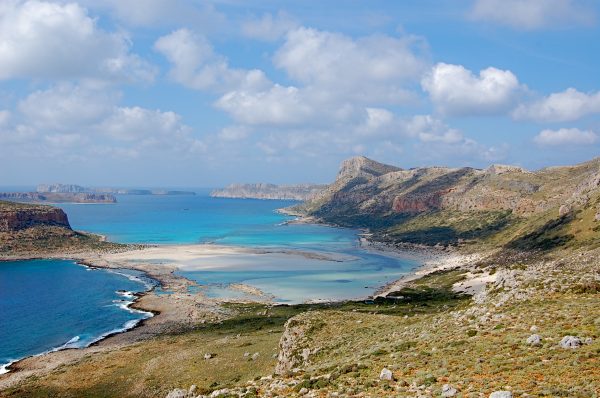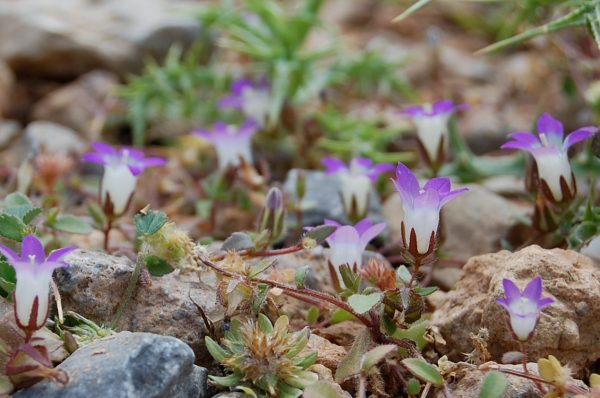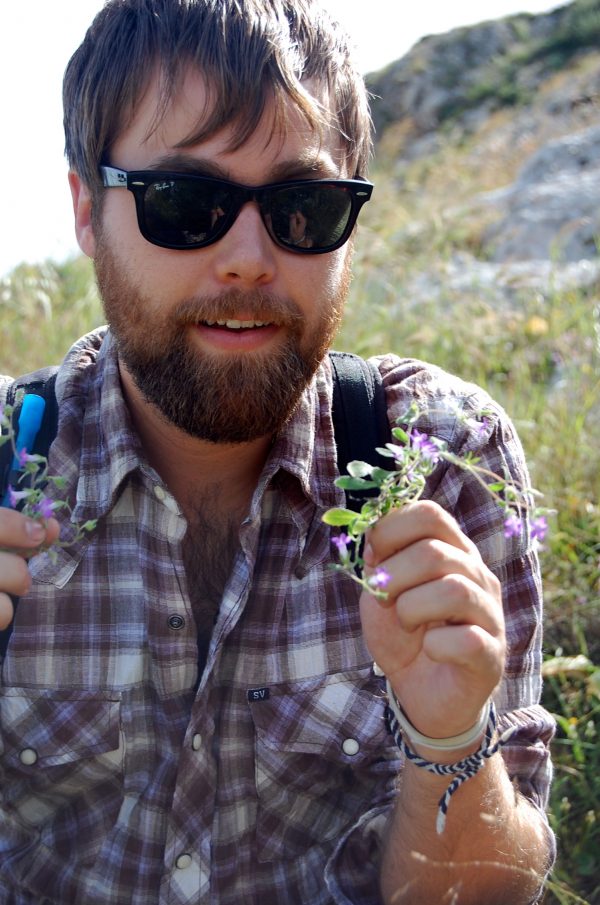
Florida Museum photo by Andrew Crowl
From the jungles of Southeast Asia to the Greek Islands, Florida Museum of Natural History botanist Nico Cellinese has searched for the answers to how evolution works. But during fieldwork in the Mediterranean Basin—a biodiversity hotspot—she found more questions than answers.
“There are so many islands and so many island endemic species in the basin that it makes you wonder what is going on in this place to make it so highly dynamic,” said Cellinese, associate curator of the Florida Museum Herbarium and Informatics. “It’s a very peculiar place. It’s the kind of place you just have to dive into, and not stop until you figure something out.”
Cellinese received a National Science Foundation $865,000 Early Faculty Development Career Program Award in 2010 to investigate the basin’s rich biodiversity and better understand why certain species only occur there. The grant has supported Cellinese’s research on genetic diversity in the flowering plant group Campanulaceae, also known as the bellflower family—a model group for studying the influences of geological activity, climate change and human pressure on island evolution and endemism.
The five-year award has resulted in the study of nearly 1,000 species of bellflowers worldwide, focusing on those restricted to islands in the Mediterranean Basin. The research adds to the work of Charles Darwin and Alfred Russell Wallace, who were the first to notice differences in the geology and biological diversity of continental islands like those in the Mediterranean Basin, which have a past connection with the mainland, and oceanic islands—those formed by volcanic or tectonic events and rise from the ocean without any history of continental contact.
Both types of islands are present in the eastern Mediterranean Basin, a center of diversity for bellflowers. Crete, Karpathos, Kos, Rhodes and other numerous small islands off the west coast of Turkey were once connected to the mainland, while islands like Cyprus rose from the ocean. Because continental islands have been studied less than oceanic islands, little was known about the evolution of endemic lineages of the bellflowers, Cellinese said.
Andrew Crowl, a University of Florida doctoral student working in Cellinese’s lab, was drawn to this research by the peculiar diversity of the Mediterranean Basin. He wanted to know more about the evolutionary origins of the Roucela group, or 13 closely related bellflowers found primarily in the eastern Mediterranean Basin.

Florida Museum of Natural History photo by Andrew Crowl
The small, herbaceous species with bright purple blooms are rare and restricted to a few islands in the Aegean Archipelago, Cyprus and western Turkey. One species, C. erinus, however, is found from the Azores, southern Europe and northern Africa, to the Arabian Peninsula, which has a climate similar to the Mediterranean. Crowl believes the widespread nature of Campanula erinus may be due to this species’ ability to self-pollinate and its genetic structure.
By reconstructing the evolutionary history of the broader Campanuloidae clade and utilizing the fossil record, Crowl and Cellinese found the group to be much older than previously thought. Molecular dating, diversification and ecological niche modeling techniques were used to establish timing of speciation events and link these to past geologic events in the area. They also tested the importance of climate change in driving diversification of the bellflowers and influencing their spread across the Mediterranean
“This research is a model for looking at evolution on islands, but mainly the islands of the Mediterranean,” Crowl said. “One of the big questions is how does evolution happen on these continental islands and how is it different from oceanic islands.”
Like a modern day Odysseus, Crowl traveled throughout the Mediterranean on his mission. Over three years, he collected hundreds of bellflower specimens from some of the Basin’s most remote islands. Beginning in the Azores islands and ending along the coast of Turkey, Crowl withstood the dry, hot climate—a climate that evolved from a more subtropical environment and culminated with the onset of the current Mediterranean climate about 2 million years ago.
“The geologic and climatic history of the eastern Mediterranean since the Miocene is a complex combination of tectonic events, sea level changes, volcanism and a trend toward summer drought, cool rainy winters and increased seasonality,” Crowl said.
But contrary to past studies of Mediterranean biota, Crowl’s results show this move away from a subtropical climate has actually slowed down diversification in the Roucela species group.
“In the case of the Roucela bellflowers, the evolution of Mediterranean climate hasn’t driven diversification,” he said. “It has hindered it. What we’ve found is that the onset of this type of climate may actually be causing these species to go extinct. The timing of the evolution of these taxa suggests that they evolved during a time of subtropical climate. Then you get this drying and cooling, and the Roucela group is just not adapted to that.”

Florida Museum photo by Andrew Crowl
The negative impact on the Roucela group of climatic shifts that lead to the Mediterranean’s dry climate is an exception, however. There are many other plants that have evolved and are thriving as the result of the onset of the current Mediterranean environment, Cellinese said.
“Plants do all they can to survive,” Crowl said. “They find strategies that help them hang around.”
Cellinese added, “But as researchers, we want to learn about the exceptions, because the exceptions are the first things to go extinct.”
On continental islands, flora and fauna do not need to migrate to the islands like they do on oceanic islands, Cellinese said. Instead, a balance of plant and animal life already exists on islands when they become isolated from the mainland. However, throughout history, the Mediterranean Sea has risen, fallen and even dried up almost completely as it did during the Messinian Salinity Crisis 5 million years ago.
“There were times when it dried up and then became reconnected to previously isolated islands, so the organisms were able to move around from island to island and from islands back to mainland,” Cellinese said. “That’s why understanding the evolutionary history of this area is so complicated.”
These events greatly affected the region’s composition of plant and animal species, Cellinese said.
By studying the Roucela group in an evolutionary and biogeographic context, Crowl’s research also highlights the diversity and complexity of historical processes driving plant evolution in the Mediterranean. The development of the group was likely the result of ancient geologic and tectonic events that led to numerous cycles of island connection and isolation, Crowl said.
The results of his research suggest that the break-up of an ancient Aegean landmass was responsible for driving diversification of these species.
“Tops of mountains became islands and slowly moved away from each other,” Crowl said. “You have these populations that are essentially trapped on islands. Over time, you may end up with new species or extinction.”
Because the Mediterranean Basin is one of the most biologically diverse places on the planet, Crowl said more research into the origin of this biodiversity is essential to understanding how diversity is “built” in general. While other researchers have called the bellflowers of the Roucela group rare, Crowl is the first to point out they may actually be in danger of becoming extinct.
“Future climate change is predicted to have even hotter and drier periods,” Crowl said. “The trend that we’re seeing is that these hot, dry periods are slowing diversification of the bellflowers. That’s going to get worse and worse. They may very well become extinct unless we do something.”
Learn more about the Herbarium at the Florida Museum.